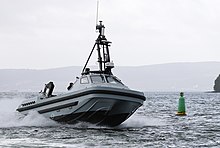9th Mine Counter-Measures Squadron
| 9th Mine Countermeasures Squadron | |
|---|---|
| Active | 1962–1971, 2013–present[1] |
| Country | United Kingdom |
| Branch | Royal Navy |
| Type | Squadron |
| Role | Mine Countermeasures Squadron |
| Size | 5 ships as of 2017; 4 ships in 2023; 3 ships as of 2024-25[2] |
| Home port | HMS Jufair, Bahrain |
The 9th Mine Countermeasures Squadron is a front-line squadron of the Royal Navy with responsibility for mine warfare in the Persian Gulf region. The squadron is based in Bahrain and, as of 2024-25, is equipped with three mine countermeasure vessels. Normally, a Royal Fleet Auxiliary (RFA) support ship has also been assigned to the squadron. However, in late 2024 the squadron's normal support ship, RFA Cardigan Bay, returned to the UK for refit and acute personnel shortages in the RFA made her return to the Gulf uncertain.[3]
History
[edit]1962–1971
[edit]In its original guise, the 9th Mine Sweeping Squadron (MSS) was formed of four Ton-class sweepers – HM Ships Appleton, Kemerton, Flockton and Chilcompton which were specially fitted for the rigours of operating in the Persian Gulf. The ships had their pennant numbers painted in Arabic on the stern and carried a funnel badge featuring a dhow on a yellow background.[1]
The squadron was based in Aden and later Bahrain.[4] When Bahrain and Qatar became independent nations and Trucial States formed into the United Arab Emirates, the squadron was disbanded.[5]
2013–present
[edit]The squadron was reformed in 2013 as the 9th Mine Countermeasures Squadron, the change in title reflecting the advances in mine countermeasures techniques in the intervening 40 years. Up until the early 2020s, the squadron usually consisted of two Hunt-class mine countermeasures vessels and two Sandown-class single role minehunters on three year rotations, supported by a Royal Fleet Auxiliary Bay-class landing ship, normally RFA Cardigan Bay.[1] As in its original guise, the squadron operates out of HMS Jufair in Bahrain and carries the same funnel badge.[6]


With the planned retirement of all the remaining Sandown-class vessels by 2025, and their replacement with both autonomous minehunting systems and supporting "motherships", at minimum a new configuration of the squadron was likely.[7] In February 2023, the autonomous minehunting vessel RNMB Harrier arrived in Bahrain to begin trials of autonomous systems in hot weather. The autonomous vessel was to operate from RFA Cardigan Bay.[8][9]
In April 2024 a gap in the capability of the squadron was created when Cardigan Bay deployed, initially to the Mediterranean to contribute to the British presence there in the context of the Israel-Hamas War, and then, in August, to the U.K. for refit.[10]
References
[edit]- ^ a b c "Badge of honour for Gulf minehunters as historic squadron is reborn". Navy News. Archived from the original on 28 April 2017. Retrieved 27 April 2017.
- ^ "HMS Bangor being repaired in Bahrain following damage sustained earlier this year". Navy Lookout. 9 November 2024.
- ^ "HMS Bangor being repaired in Bahrain following damage sustained earlier this year". Navy Lookout. 9 November 2024.
- ^ "Appleton M1106". Ton Class Association. Retrieved 28 April 2017.
- ^ Roberts, John (2009). Safeguarding the Nation: The Story of the Modern Royal Navy. Seaforth Publishing. p. 92. ISBN 9781848320437.
- ^ "Reborn Identity for Mine Countermeasure Squadron". Royalnavy.mod.uk. 5 September 2013. Retrieved 28 April 2017.
- ^ "Mothership to support autonomous mine hunting systems arrives in the UK". Navy Lookout. 30 January 2023. Retrieved 30 January 2023.
- ^ @NavyLookout (13 February 2023). "Autonomous minehunting vessel RNMB Harrier has arrived in Bahrain and will be based on @RFACardiganBay" (Tweet). Retrieved 13 February 2023 – via Twitter.
- ^ "Autonomous minehunting test team mark one year in the Gulf". Royal Navy. 13 March 2024. Retrieved 12 June 2024.
- ^ @NavyLookout (12 August 2024). "@NavyLookout MoD says @RFAMountsBay has replaced @RFACardiganBay in the Mediterranean as part of routine ship and crew rotation" (Tweet). Retrieved 14 August 2024 – via Twitter.
